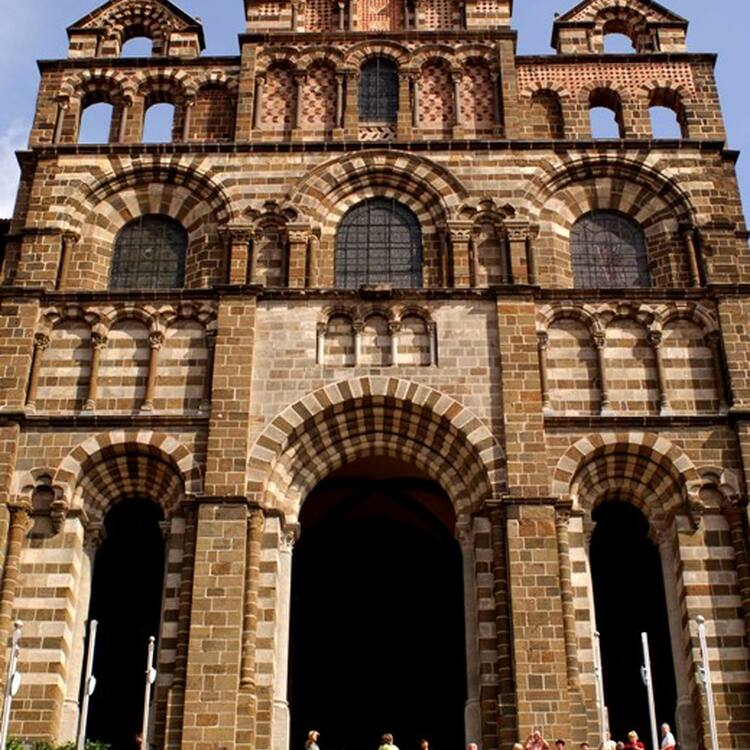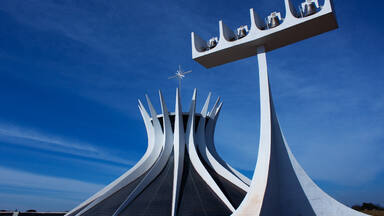Routes of Santiago de Compostela in France
Routes of Santiago de Compostela in France
Santiago de Compostela was the supreme goal for countless thousands of pious pilgrims who converged there from all over Europe throughout the Middle Ages. To reach Spain pilgrims had to pass through France, and the group of important historical monuments included in this inscription marks out the four routes by which they did so.
Description is available under license CC-BY-SA IGO 3.0
Chemins de Saint-Jacques-de-Compostelle en France
Tout au long du Moyen Âge, Saint-Jacques-de-Compostelle fut la plus importante de toutes les destinations pour d'innombrables pèlerins venant de toute l'Europe. Pour atteindre l'Espagne, les pèlerins devaient traverser la France, et les monuments historiques notables qui constituent la présente inscription sur la Liste du patrimoine mondial étaient des jalons sur les quatre routes qu'ils empruntaient.
Description is available under license CC-BY-SA IGO 3.0
طرق سان جاك دو كومبوستيل في فرنسا
طيلة فترة القرون الوسطى، كانت طرق سان جاك دو كومبوستيل الأهمّ في كافة الاتجاهات للحُجاج القادمين من كافة أنحاء أوروبا الذين لا يُحصى عددهم، في سبيل بلوغ إسبانيا. كان يجدر بالحُجاج أن يجتازوا فرنسا، وكانت النُصب التذكارية التاريخية البارزة التي تندرج اليوم على قائمة التراث العالمي تمهّد السبيل أمام الطرق الأربعة التي كانوا يسلكونها.
source: UNESCO/CPE
Description is available under license CC-BY-SA IGO 3.0
法国圣地亚哥——德孔波斯特拉朝圣之路
圣地亚哥——德孔波斯特拉在整个中世纪是成千上万虔诚朝圣者们的终极目标,他们从欧洲各地蜂拥至此,为了到达西班牙,他们必须穿越法国。列入世界遗产的项目包括系列重要的历史古迹,标出了朝圣者穿越法国的路线。
source: UNESCO/CPE
Description is available under license CC-BY-SA IGO 3.0
Дороги во Франции, ведущие в Сантьяго-де-Компостела
Испанский город Сантьяго-де-Компостела был заветной целью бесчисленных набожных паломников, стекавшихся туда в Средние века со всей Европы. Чтобы попасть в Испанию, паломники должны были пройти через Францию. Четыре основных пути, по которым они следовали, и целый ряд важных исторических памятников включены в этот объект всемирного наследия.
source: UNESCO/CPE
Description is available under license CC-BY-SA IGO 3.0
Caminos de Santiago de Compostela en Francia
A lo largo de toda la Edad Media, Santiago de Compostela fue el lugar de peregrinación más importante de la cristiandad, adonde acudían miles de devotos procedentes de toda Europa. Las cuatro rutas por las que transitaban los peregrinos en Francia, antes de alcanzar España, están jalonadas de importantes monumentos históricos hoy inscritos en la Lista del Patrimonio Mundial.
source: UNESCO/CPE
Description is available under license CC-BY-SA IGO 3.0
フランスのサンティアゴ・デ・コンポステーラの巡礼路
スペイン北西部の聖地サンティアゴ・デ・コンポステーラは、中世を通じてヨーロッパ各地から集まってくる無数の敬虔な巡礼者にとって、最終の目的地であった。ピレネー山脈を越えてスペインの巡礼路に到達するには、彼らはフランスを通過せねばならなかった。世界遺産リストに記載されている一群の重要な歴史記念物は、彼らがたどったフランスの主要な4つのルート(起点はパリ、ヴェズレイ、ル・ピュイ、アルル)を際だった存在としている。source: NFUAJ
Routes van Santiago de Compostella in Frankrijk
Santiago de Compostella in Spanje was het hoogste doel voor talloze duizenden vrome pelgrims die daar samen kwamen uit heel Europa tijdens de middeleeuwen. Om de plek te bereiken moesten de pelgrims door Frankrijk reizen. De vier belangrijkste pelgrimsroutes naar Santiago de Compostella begonnen in Parijs, Vezelay, Le Puy en Arles. Aan deze routes staan belangrijke historische monumenten, die speciaal gebouwd werden om te voorzien in de geestelijke en lichamelijke behoeften van de pelgrims. Hieronder vallen grote kathedralen zoals die van Amiens, maar ook parochiekerken, hospices en bruggen. Sommigen daarvan zijn bekend zijn als ‘pelgrimsbruggen’.
Source: unesco.nl
Outstanding Universal Value
Brief synthesis
Throughout the Middle Ages, Santiago de Compostela was a major destination for numerous pilgrims from all over Europe. To reach Spain, the pilgrims had to pass through France. Four symbolic routes depart from Paris, Vézelay, Le Puy and Arles and cross the Pyrenees, joining the numerous itineraries taken by the travellers. Pilgrimage churches, simple sanctuaries, hospitals, bridges, roadside crosses bear witness to the spiritual and physical aspects of the pilgrimages. Spiritual exercise and manifestation of faith, the pilgrimage has also influenced the secular world in playing a decisive role in the birth and circulation of ideas and art.
Large sanctuaries, such as the Saint Sernin Church in Toulouse or Amiens Cathedral - some cited in the Calixtine Codex - as well as other properties, illustrate the routes and conditions of the pilgrimage over the centuries. Seventy-one elements associated with the pilgrimage have been retained to illustrate their geographic diversity, the chronological development of the pilgrimage between the 11th and 15th centuries, and the essential functions of the architecture, such as the old hospital for pilgrims at Pons, or the “Pilgrims” Bridge over the Boralde. In addition, seven sections of the Chemin du Puy are included, covering nearly 160 km of the route.
Criterion (ii): The Pilgrimage Route of Santiago de Compostela played a key role in religious and cultural exchange and development during the later Middle Ages, and this is admirably illustrated by the carefully selected monuments on the routes followed by pilgrims in France.
Criterion (iv): The spiritual and physical well-being of the pilgrims travelling to Santiago de Compostela were met by the development of a number of specialized types of edifice, many of which originated or were further developed on the French sections.
Criterion (vi): The Pilgrimage Route of Santiago de Compostela bears exceptional witness to the power and influence of the Christian faith among people of all classes and countries in Europe during in the Middle Ages.
Integrity
The proposed edifices and ensembles represent, in their diversity, a true evocation of the context of the pilgrimage to Santiago de Compostela. The same applies to proposed sectors of the route that are only examples of the ensemble of the routes followed by the pilgrims. The edifices along the route share in common the direct testimony, conserved and transmitted to the present day, of the practice of the pilgrimage as it occurred in France in the Middle Ages. The intact evocative power has revitalized a cultural approach of the pilgrimage to Compostela. Since the 1990s, the Routes of Santiago de Compostela in France are the subject of continually increasing numbers of visitors, which has to be accommodated with road development.
Authenticity
The accommodation and care establishments presented are undoubtedly devoted to the pilgrimage by the historic texts and the conserved architectural or decorative elements. The properties presented illustrate in the most loyal and credible manner the ensemble of rituals and practises linked to the pilgrimage to Santiago de Compostela. This includes the routes, pilgrimage churches or simple sanctuaries, hospitals and bridges. The spiritual path of the pilgrimage was marked by the veneration of relics of saints along the itinerary. The richest edifices, privileged points of passage of the route, are recognizable for their specific architectural layout, suitable for organizing the circulation of pilgrims. The more modest churches, stops for contemplation or rest, located on the main or secondary routes, bear testimony by their sculpted and painted decor representing religious scenes or legends linked to the devotion of Saint James.
Protection and management requirements
The 71 edifices and building ensembles are for the most part the property of the communes, and in some cases, property of the Departmental Council and private individuals. The majority of the religious buildings are devoted to the Catholic faith. Their conservation is the responsibility of their owners, with financial assistance and under the technical and scientific control of the services of the State.
They are covered by protective measures in application of the Heritage Code (listing or inscription as Historic Monument), the Environment Code, as well as local urbanism plans (PLU). These buildings also generate protective boundaries of 500 m. Some of the boundaries are susceptible to modification in order to render the protective area more relevant.
Furthermore, the areas where the buildings and ensembles are located also benefit from protection either under the Heritage Code (remarkable heritage sites), or under the Environment Code (listed or inscribed sites).
In any event, these protective boundaries ensure that the advice of the territorial architectural and heritage services is mandatory to authorize all works.
The sections of the route included in the inscribed property are the Grande Randonnée hiking trails (GR65) that benefit for the most part, from protection under the Departmental Plan for Walking and Hiking Routes (PDIPR).
It also benefits from the protection of the different historic monuments that are found along the route.
The management of the property is coordinated at the national level by the Prefect of the Occitanie Region, who was appointed Prefect Coordinator. The Prefect chairs the Interregional Coordinating Committee that annually brings together all the owners of the components of the property. The Prefect also relies on the Agency for Interregional Cooperation and Network of the Routes of Saint-Jacques-de-Compostelle (ACIR), manager of the inscribed site

 View photos from OUR PLACE the World Heritage collection
View photos from OUR PLACE the World Heritage collection